Banpo Village › Barnhouse Settlement › Etruscan Bronze Sculpture » Origins and History
Articles and Definitions › Contents
- Banpo Village › Origins
- Barnhouse Settlement › Origins
- Etruscan Bronze Sculpture › Origins
Ancient civilizations › Historical places, and their characters
Banpo Village › Origins
Definition and Origins
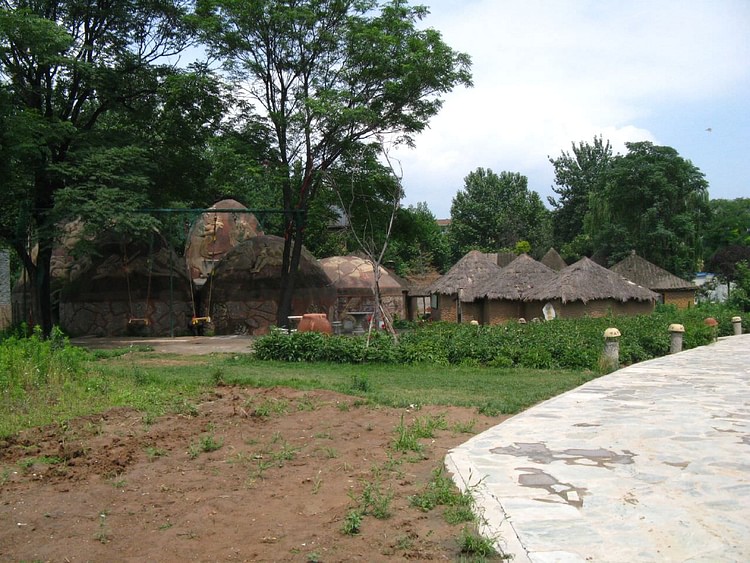
Banpo Village is a Neolithic site in the Yellow River Valley, east of Xi'an, Shaanxi Province, in the People's Republic of China. The site is also referred to as Pan Po, especially by writers in the late 1950's CE. It was discovered in 1953 CE by workers hired to dig up the ground to build a factory. The site was occupied from c. 4500-3750 BCE and covers almost 20 acres. Over 10,000 stone tools and artifacts, 250 tombs, six large kilns, storage pits, and almost 100 foundations of buildings have been excavated at the site. It was the first large-scale archaeological operation of the People's Republic of China and is one of the most significant Neolithic sites in the world.
DISCOVERY & NAME
In 1953 CE local workers were hired to dig the foundation for a factory that was to be built at the site. The name means `half slope' and comes from the area near the site. Historian Marilyn Shea writes that the village gets it name from the Banpo work group who uncovered it and how, "once the find was identified, the work group changed occupations and became diggers for the archaeologists. Eventually the dig was turned over to the Institute for Archaeological Research at the Chinese Academy of Science " (1). The original name of the village is not known. Excavations continued from 1953-1957 CE, and the Banpo Museum, located near the site, was opened in 1958 CE, displaying artifacts from the site and reconstructions of the homes and buildings. The Banpo Museum is the first of its kind in China featuring artifacts from a dig at the site of the excavations.
NONE OF THE GRAVES EXCAVATED AT BANPO VILLAGE SHOW ANY INDICATION OF A MALE CHIEFTAIN, BUT PLENTY OF EVIDENCE FOR FEMALE LEADERS EXISTS.
THE NEOLITHIC VILLAGE
Archaeologists have designated Banpo a type site, which means a representative model of a particular culture, in this case the Yangshao Culture, which flourished in the Yellow River Valley between 5000-3000 BCE. Banpo is a ditch-enclosed settlement that was surrounded by a moat. The homes were dug to three feet (1 meter) below ground level and the soil then used to fashion the foundations for the walls. Walls were made of wood and topped by a thatch roof. Clay and wattle was then used to daub the walls for insulation, and the walls reinforced with fire-baked clay. Every building in the village was circular, and the village itself oval-shaped. The houses had hard-baked clay floors and front porches, which were shaded by the over-hanging roof of thatch. The cemetery was located outside of the village, beyond the moat, and so was the ceramics factory. The six kilns for firing ceramics at Banpo have all been found in one location outside the village, suggesting a kind of industrial complex there where communal pottery was shaped and fired. The inhabitants of Banpo did not use a potter's wheel but shaped every ceramic by hand.
THE CULTURE
The Yangshao Culture was matrilineal, meaning that women were in charge and one's ancestry was traced through the mother's line, not the father's. Although western scholars have disputed this claim as some "Marxist invention," the physical evidence from Banpo speaks for itself: every female's grave that has been opened has more grave goods than the males; and no grave of the 250 discovered and excavated show any indication of a male chieftain but plenty of evidence for female leaders (based on the number of grave goods and the type). This points toward a matrilineal society in the strictest sense of women being in power and men subordinate.
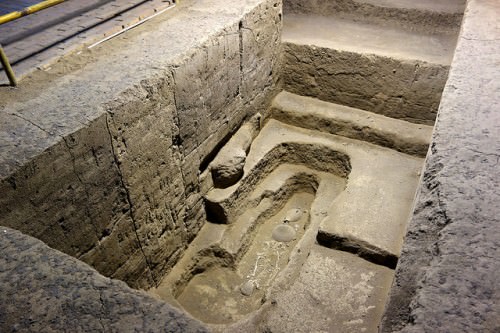
Banpo Village Tomb
FARMING, CERAMICS, & CLOTHING
The people of Banpo were hunter-gatherers who then shifted to an agrarian culture (farming). Farm implements like sickles and plows have been found on site. They ate primarily millet (cereals) and kept domesticated dogs and pigs. They were primarily vegetarian (like most Neolithic cultures) although there is evidence of occasional meat-eating from fishing and hunting.
Their ceramics were highly developed, and one of the most interesting designs is the pointed amphora (also known as the "sharp-bottom water bottle"), which is an oval-shaped ceramic jug with a handle on each side, a thin, short, neck and a pointed bottom. The point at the bottom would seem impractical because the jug would tip over, but archaeologists believe the jugs were placed firmly in earth or soft clay and were more stable than flat-bottomed jugs, which could fall over more easily. The pottery was decorated with animal motifs, geometric designs, human faces (possibly deities) and dragons. The now-famous Chinese dragon shape appears on the ceramics excavated from Banpo.
There is evidence that the people of Banpo wore woven cloth garments. Such cloth has been found on human remains in graves and attached to artifacts. No evidence of ancient looms has been discovered, however. What these clothes may have looked like is unknown because of the state of decomposition of the cloth fragments.
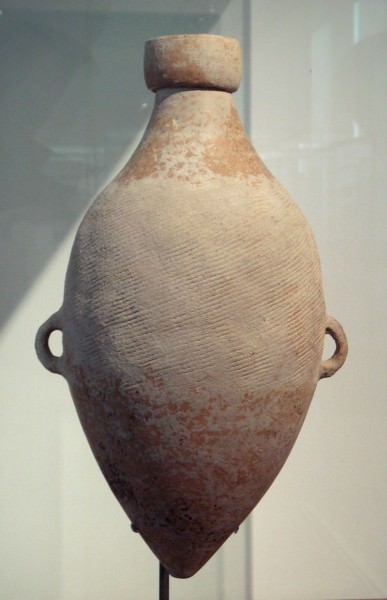
Amphora, Banpo Village
MARRIAGE & CHILDREARING
Women and men wore ornaments and jewelry but the females more than the males. Their marriages were arranged quite differently from the pattern most people recognize today. Archaeological evidence strongly suggests they practiced what the Chinese call zouhun - "free love" - which is sexual relations without commitment. Men would visit women's homes at night and sleep with them and then leave in the morning to return to their mother's house and work their mother's land. Children were raised by the mother in her mother's house. This type of marital relationship is still practiced in China today by the Mosuo people (known as the Na to themselves) of the Yunnan and Sichuan provinces near Tibet. The Ah mi (elder female) is the head of the household and makes all of the important decisions. The evidence found in the homes at Banpo suggest the children were raised by their mothers in the same way the Mosuo people do today.
WRITING
Banpo may have developed a system of writing long before the traditional date of the rise of literacy in China during the Shang Dynasty (1600-1046 BCE). Scratch marks on ceramic shards have been classified into 27 distinct categories, which suggest a form of communication and are not at all random. What the scratch marks may mean is unknown, and archaeologists do not even all agree that they are a form of written language.
CONCLUSION
Banpo Village was abandoned at some point c. 3750 BCE. No satisfactory reason has been found for the people leaving their homes. Evidence of ancient flood damage at the site is inconclusive because there is no way of knowing whether it happened before or after the people left. The village was abandoned quickly, however, and so a flood may have been the cause. Today the ancient village is one of the most visited sites in China after The Great Wall. Thousands of people every year - as many as 50,000 - make the trip and take the time to walk the ancient pathways of Banpo Village.
Barnhouse Settlement › Origins
Definition and Origins
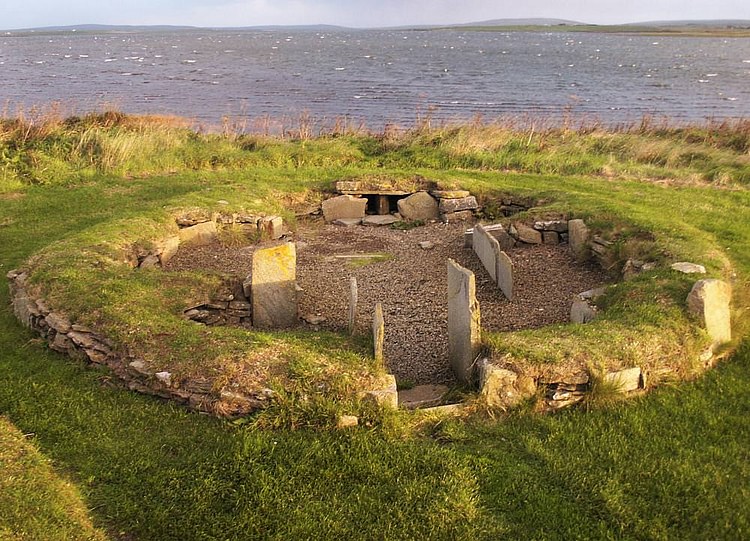
The Barnhouse Settlement is a Neolithic village located in Antaness, Orkney, Scotland, which was inhabited between c.3300 and 2600 BCE. The present designation of `Barnhouse' comes from the name of the farmland on which the village was discovered in 1984 CE by the archaeologist Dr. Colin Richards. Excavation of the site began in 1986 CE, revealing ten stone buildings which conformed in design and construction, though not in style, to the village of Skara Brae (c. 3100 BCE) located 5 miles (8 km) to the north-west. Only the foundations of these buildings remain intact as the village was deliberately destroyed, seemingly by the inhabitants, in 2600 BCE and centuries of agricultural activity on the farm displaced many of the loose stones. Grooved Ware pottery found at the site further links Barnhouse to Skara Brae and also to the nearby Standing Stones of Stenness where similar ceramics were uncovered. To date, fifteen buildings have been excavated and partially reconstructed. Unlike Skara Brae, where the houses were built into the earth and surrounded by midden, the structures which comprise Barnhouse were free standing. Most of these are small buildings which appear to have been homes while two large structures seem to have served other purposes.
BARNHOUSE AS A CEREMONIAL SITE
The site also comprises the famous monolith known as the Barnhouse Stone which is aligned directly to the passage entrance of Maeshowe, half a mile (800 metres) to the north-east and to the Standing Stones of Stenness, by the same distance, to the north-west, to form a kind of triangle between the three structures. The Barnhouse Stone is thought to have played a significant role in rituals performed at these nearby sites as did the village itself. Proximity to the enormous complex presently being excavated at the Ness of Brodgar, and the alignment of Maeshowe, Barnhouse, the Standing Stones of Stenness, the Watchstone, Ness of Brodgar, and Ring of Brodgar, seem to confirm a clear connection between all these sites. Mr. Peter Flett observed, in 1952 CE, that the Barnhouse Stone is aligned with the Watchstone in a direct line to the centre of the Ring of Brodgar and points to the rising sun on 1 May, the traditional date of the pagan Sabbat of Beltane (Orkneyjar.com).
MANY BUILDINGS FEATURE A CENTRAL, KERBED HEARTH, STONE FURNITURE, RECESSED STONE BEDS, & 'DRESSERS'.
The buildings of the village were constructed along the same lines as those at Skara Brae and many feature the same design of a central, kerbed hearth, stone furniture, recessed stone beds, and `dressers'. The two large buildings designated Structure Two and Structure Eight, however, are noticeably different in style and size and suggest use as ritualistic community centres rather than domiciles. All the houses at Skara Brae are identical in feature and size and this has been interpreted to mean that the community considered everyone in the village as equally important, with no chief or ruling class given any special accommodations. These two larger structures at Barnhouse suggest the theory that this community was centred on someone, or something, they considered of great importance. As the Barnhouse Settlement lies in proximity to so many other sites clearly identified as ceremonial in nature, it has been suggested that the larger structures were the dwellings of a priestly class who officiated at rituals held at Maeshowe, the Standing Stones of Stenness, The Ness of Brodgar, and Ring of Brodgar. It is equally possible, however, that the two structures were themselves ceremonial sites.
STRUCTURE TWO & STRUCTURE EIGHT
Structure Two conforms to the design of a chambered cairn in which rituals were known to take place elsewhere and Structure Eight contains a `dresser', which has been interpreted as a kind of altar, as well as what appears to have been offerings. One such offering, perhaps, is a Grooved Ware ceramic pot, containing fourteen pieces of flint, found near the hearth in Structure Eight. As flint was rare on Orkney, a pot containing fourteen nodules of the stone would have been very valuable and considered an impressive sacrifice. As there is no way to determine what the ceramic pot of stone signified to the ancients, however, it is unknown whether the flint was an offering or simply a valuable which was kept by the hearth.
That Structure Two could have been the home of a person or persons of importance, is possible as the building was in use throughout the life of the village. Certain features, however, such as a stone cist filled with human bones, suggests a ritual use.This cist, covered by a triangle of stone, was positioned so that anyone entering the building would have to walk across it.Further, the chambers of Structure Two do not conform to other sites (such as Skara Brae) where sleeping quarters have been identified. The purpose and use of Structure Eight (located directly across from Structure Two) is equally mysterious.

Structure 8, Barnhouse Settlement
Structure Eight is the largest edifice in the village and is built, like Maeshowe, on a platform of clay. The building was originally roofed (as all the structures of the village were) and contained a central hearth and `dresser' flanked by two large stones. The layout of the interior, especially the long passageway between the entrance and the hearth and dresser, suggests a definite ritual use. It has been suggested that this building represents a shift in religious understanding as the paradigm of services changed from outdoor ceremonies, which included the entire community, to cloistered rituals which were only for the initiated.This theory seems to rest partially on dating the Standing Stones of Stenness, where open air rituals were known to have taken place, earlier than the accepted date of 3000 BCE. It has therefore been argued, especially in light of the recent excavations at the Ness of Brodgar, that Structure Eight was another of the ceremonial sites which made up part of what is now seen as a complex stretching from Barnhouse through the sites leading to the Ring of Brodgar and is not evidence of change in religious understanding. The evidence of offerings at the hearth in Structure Eight and the bone-filled cist in Structure Two have been seen to support the theory that these buildings were used to either commune with, remember, or honor the dead and this seems in keeping with finds at the Ness of Brodgar.

House 3, Barnhouse Settlement
BARNHOUSE ABANDONMENT
It is well substantiated that Barnhouse Settlement (including Structure Two) and the Standing Stones of Stenness were in use at the same time but, it should be noted, Structure Eight was built later than the rest of the village (c. 2600 BCE) and, in fact, after the village had been abandoned and purposefully destroyed. Evidence suggests that all of the buildings were simultaneously demolished sometime around 2600 BCE at the same time Structure Eight was raised and this has further bolstered the theory of a dramatic change in religious understanding and practice dated to this time. The existence of the `blocking stone' in the entrance passage at Maeshowe has been interpreted as evidence that closed rituals may have been performed at that site as well. Since no definite evidence found thus far fully substantiates this theory, however, it must remain conjecture. Skara Brae was once thought to be unique until the discovery of Barnhouse and Structure Eight was the largest roofed Neolithic Age building to be uncovered until the recent discovery of Structure Ten at the Ness of Brodgar. Excavations at that site have already changed the way the other nearby sites are understood and archaeologists are confident that continuing work there will reveal many more important finds which will further clarify what now remains mysterious.
Etruscan Bronze Sculpture › Origins
Ancient Civilizations
The Etruscans produced bronze goods going back to the Villanovan period (1100-750 BCE) and used the material for all manner of objects, but it is their figure sculptures which have become some of the star attractions in museums worldwide.Bronze was a highly desirable material throughout antiquity and easily melted down for reuse so that it is even more remarkable that such fine works as the Chimera of Arezzo and Mars of Todi have survived to bear testimony today of the exquisite artistry of Italy 's first great civilization.

Etruscan Bronze Youth
MANUFACTURE
Etruria was fortunate to have rich metal resources, especially copper, iron, lead, and silver. The early Etruscans put these to good use and bronze was used to manufacture a wide range of goods such as tools, weapons, armour, coinage, jewellery, hand fans, oil lamps, incense burners, mirrors, tripods, everyday dishes and utensils, cauldrons, horse bits, chests, and even chariots. Bronze was hammered, cut, cast using moulds or the lost-wax technique, embossed, engraved and riveted in a full range of techniques.
Beginning in the mid-8th century BCE, Etruscan artists benefitted from contact with Greek settlers (especially Euboeans) and traders from Phoenicia, Sardinia, Egypt, central Europe, and the Balkans. This brought technological refinements in metalwork and a whole new range of art ideas.
Many Etruscan towns set up workshops specialising in the production of bronze works and these included Acquarossa, Cerveteri, Chiusi, Populonia, Tarquinia, Vulci, Volsinii, and Volterra. To give an idea of the scale of production, the Romans were said to have looted more than 2,000 bronze statues when they attacked Volsinii (modern Orvieto ) in 264 BCE, melting them down for coinage.
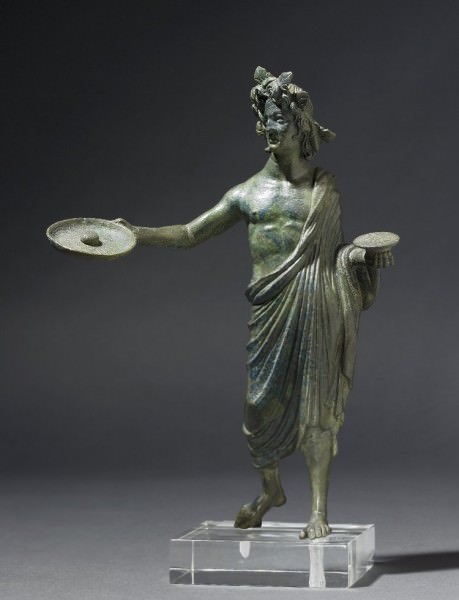
Etruscan Votive Figure
FIGURINES
Bronze figurines, often with a small stone base, were a common form of votive offering at sanctuaries and other sacred sites.Some, as with those found at the Fonte Veneziana of Arretium, were originally covered in gold leaf. An early figure is a 6th-century BCE hammered and cast bronze representation of a female goddess holding a bird from the Tomb of Isis at Vulci. It is 34 cm tall and originally had inlaid eyes and parts covered in gold foil. The figure is now in the British Museum London.
Most figurines are women in long chiton robes, naked males like the Greek kouroi, armed warriors and naked youths.Sometimes gods were presented, especially Hercules. A common pose of votive figurines is to have one arm raised (perhaps in appeal) and holding an object - commonly a pomegranate, flowers, or a circular item of food (probably a cake or cheese).Fine examples of smaller bronze works include a 6th-century BCE figurine of a man making a votive offering from the 'Tomb of the Bronze Statuette of the Offering Bearer' ( Tomba del Bronzetto di Offerente ) at Populonia. Another fine work is the 4th-century BCE statuette of two oxen and a ploughman from Arretium.
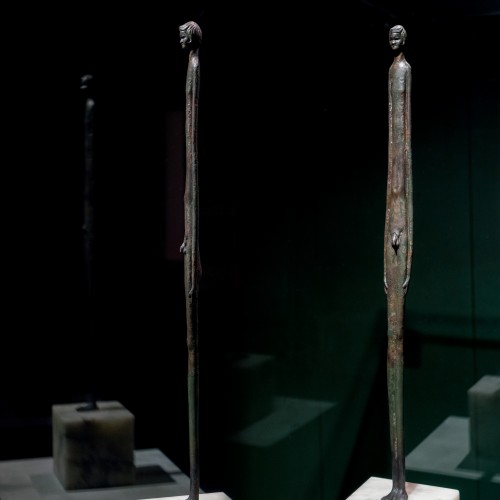
Etruscan 'Evening Shadow' Figure Sculpture
Volterra was noted for its production of distinctive bronze figurines which are extremely tall and slim human figures with tiny heads. They are perhaps a relic of much earlier figures cut from sheet bronze or carved from wood and are curiously reminiscent of modern art sculpture. The most famous example dates to the 3rd century BCE and is known as the Ombra dellaSera ('Evening Shadow'). It is a 57 cm tall representation of a naked boy who is rigidly standing to attention and wearing the hint of a smile. The figure is on display in the Museo Etrusco Guarnacci in Volterra.
REALISM OVER AESTHETICS
Etruscan artworks were exported far and wide across the Mediterranean, and many have been discovered at sacred sites such as Olympia, Delphi and Dodona. Ancient writers such as Pliny the Elder praised the Etruscans for their bronze sculpture, in particular:
We see the Tuscan Apollo, in the library of the temple of Augustus, fifty feet in height from the toe; and it is a question whether it is more remarkable for the quality of the metal, or for the beauty of the workmanship. (Keller, 232)
The historian W. Keller explains what was unique about Etruscan bronze sculpture compared to works in other contemporary cultures:
It was not the Etruscan way to concentrate on externals, to aim at an unreal, idealized perfection of form. Their dynamic, vital works pulsed with life. Whether figures of animals or of human beings, they were not regular, balanced, or ideal. Etruscan artists aimed above all at bringing out the quintessence of their subject, its individual characteristics. They strove to express the inner driving force, the unconscious depths...Etruscan artists sought to grasp the personality of a man, its tough basic core, and to convey this realistically, regardless of aesthetics. It was their works that inspired the sober realistic art of the Roman portrait. (232-3)
ETRUSCAN MASTERPIECES
Chimera of Arezzo
The Chimera is a fire-breathing monster from Greek mythology which has the head of a lion, tail of a snake and a goat's head protruding from its back. The sculpture, cast in bronze using the lost-wax technique, is 78.5 cm high and measures 129 cm in length. It dates to the 5th or 4th century BCE. The tail is the result of a restoration carried out in the 18th century CE based on a surviving fragment. It was probably part of a composition of pieces along with the hero Bellerophon, who killed the monster, and his winged horse Pegasus. There is an inscription on one leg which reads tinscvil or 'gift to Tin', indicating that it was a votive offering to the god Tin (aka Tinia), head of the Etruscan pantheon. Miraculously the sculpture was found in a ditch in 1553 CE when new fortifications were being raised at Arezzo by Cosimo de' Medici, the Grand Duke of Tuscany. It is currently on display in the Archaeological Museum of Florence.
Mars of Todi
Dating to the late 5th century or early 4th century BCE, the striking near life-size figure wears a cuirass and once held a lance.In the other hand he was probably pouring a libation. The figure is 142 cm tall and carries an inscription in Umbrian ( ahaltrutitis donum dede ) which reveals it was dedicated by Ahal Trutitis, a Celt. It is thought to have been made in Arretium, even if it was discovered near Todi where it was ritually buried in a stone-lined trench after having been struck by lightning. It is now on display in the Vatican Museums in Rome.
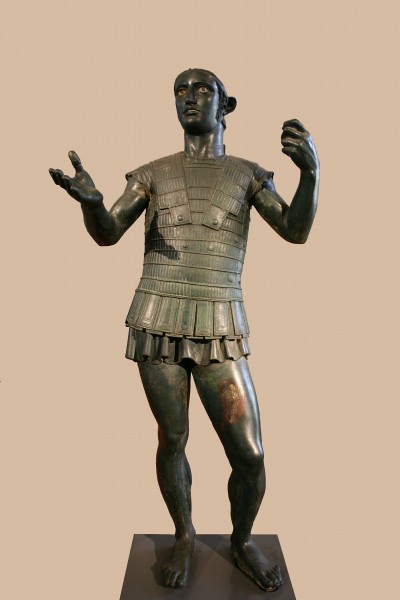
Mars of Todi
Minerva of Arezzo
This representation of Menerva, the Etruscan goddess, who was the equivalent of the Greek goddess Athena and Roman deity Minerva, was made sometime between the 3rd and 1st century BCE. Discovered in 1541 CE in a well in Arezzo, it is currently on display in the Archaeological Museum of Florence.
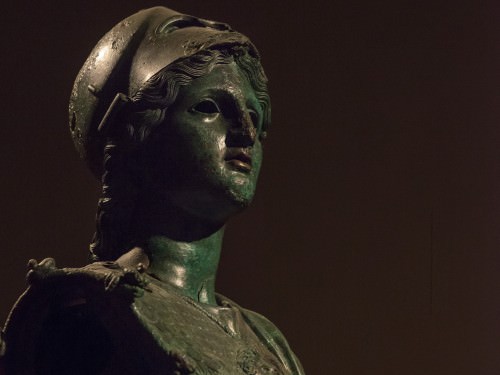
Minerva of Arezzo
Portrait of a Bearded Man 'Brutus'
This portrait head (mounted in a modern bust) has long been identified with Brutus, first consul of Rome, but there is no evidence for this association. Most art historians agree that on stylistic grounds it is an Etruscan work of around 300 BCE. It is now on display in the Capitoline Museums of Rome.
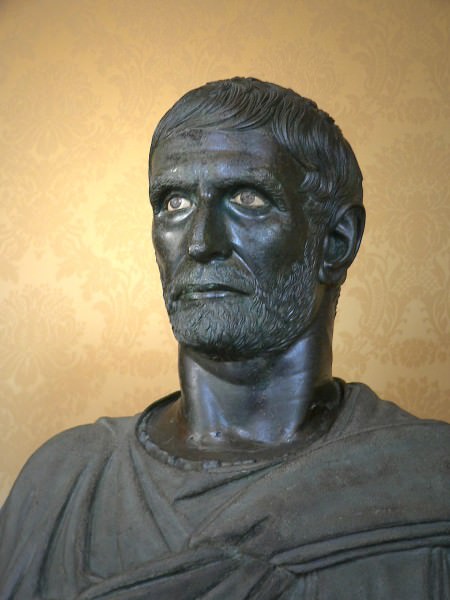
Brutus
The Arringatore (Orator)
This life-size figure was made in the first half of the 1st century BCE and represents a standing male figure wearing a short-sleeved tunic and toga with his arm outstretched as if giving a speech. An inscription indicates it was offered in the name of one Aule Meteli (whom it may or may not represent). The statue was discovered near Lake Trasimene in 1566 CE, and it is currently on display in the Archaeological Museum of Florence.

The Arringatore (Orator)
Note: the statue known as the Capitoline She-wolf which is on display in the Capitoline Museums of Rome was long thought to be an Etruscan sculpture, but is now thought to belong to the 11th or 12th century CE.
LICENSE
Article based on information obtained from these sources:with permission from the Website Ancient History Encyclopedia
Content is available under License Creative Commons: Attribution-NonCommercial-ShareAlike 3.0 Unported. CC-BY-NC-SA License